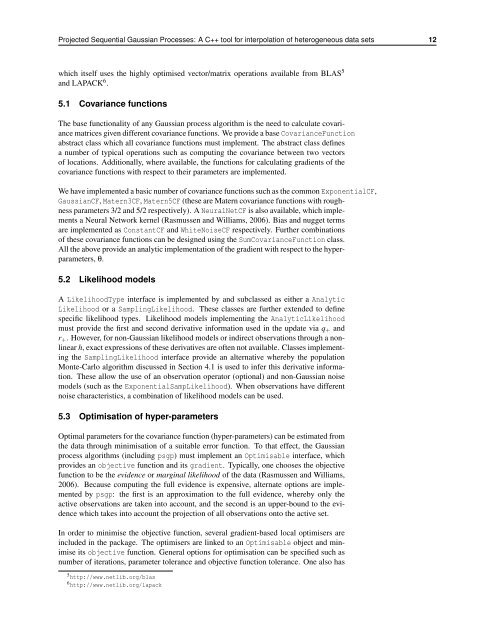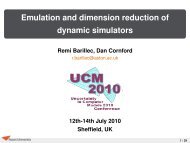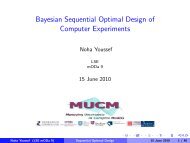Projected Sequential Gaussian Processes: A C++ tool for ... - MUCM
Projected Sequential Gaussian Processes: A C++ tool for ... - MUCM
Projected Sequential Gaussian Processes: A C++ tool for ... - MUCM
You also want an ePaper? Increase the reach of your titles
YUMPU automatically turns print PDFs into web optimized ePapers that Google loves.
<strong>Projected</strong> <strong>Sequential</strong> <strong>Gaussian</strong> <strong>Processes</strong>: A <strong>C++</strong> <strong>tool</strong> <strong>for</strong> interpolation of heterogeneous data sets 12<br />
which itself uses the highly optimised vector/matrix operations available from BLAS 5<br />
and LAPACK 6 .<br />
5.1 Covariance functions<br />
The base functionality of any <strong>Gaussian</strong> process algorithm is the need to calculate covariance<br />
matrices given different covariance functions. We provide a base CovarianceFunction<br />
abstract class which all covariance functions must implement. The abstract class defines<br />
a number of typical operations such as computing the covariance between two vectors<br />
of locations. Additionally, where available, the functions <strong>for</strong> calculating gradients of the<br />
covariance functions with respect to their parameters are implemented.<br />
We have implemented a basic number of covariance functions such as the common ExponentialCF,<br />
<strong>Gaussian</strong>CF, Matern3CF, Matern5CF (these are Matern covariance functions with roughness<br />
parameters 3/2 and 5/2 respectively). A NeuralNetCF is also available, which implements<br />
a Neural Network kernel (Rasmussen and Williams, 2006). Bias and nugget terms<br />
are implemented as ConstantCF and WhiteNoiseCF respectively. Further combinations<br />
of these covariance functions can be designed using the SumCovarianceFunction class.<br />
All the above provide an analytic implementation of the gradient with respect to the hyperparameters,<br />
θ.<br />
5.2 Likelihood models<br />
A LikelihoodType interface is implemented by and subclassed as either a Analytic<br />
Likelihood or a SamplingLikelihood. These classes are further extended to define<br />
specific likelihood types. Likelihood models implementing the AnalyticLikelihood<br />
must provide the first and second derivative in<strong>for</strong>mation used in the update via q+ and<br />
r+. However, <strong>for</strong> non-<strong>Gaussian</strong> likelihood models or indirect observations through a nonlinear<br />
h, exact expressions of these derivatives are often not available. Classes implementing<br />
the SamplingLikelihood interface provide an alternative whereby the population<br />
Monte-Carlo algorithm discussed in Section 4.1 is used to infer this derivative in<strong>for</strong>mation.<br />
These allow the use of an observation operator (optional) and non-<strong>Gaussian</strong> noise<br />
models (such as the ExponentialSampLikelihood). When observations have different<br />
noise characteristics, a combination of likelihood models can be used.<br />
5.3 Optimisation of hyper-parameters<br />
Optimal parameters <strong>for</strong> the covariance function (hyper-parameters) can be estimated from<br />
the data through minimisation of a suitable error function. To that effect, the <strong>Gaussian</strong><br />
process algorithms (including psgp) must implement an Optimisable interface, which<br />
provides an objective function and its gradient. Typically, one chooses the objective<br />
function to be the evidence or marginal likelihood of the data (Rasmussen and Williams,<br />
2006). Because computing the full evidence is expensive, alternate options are implemented<br />
by psgp: the first is an approximation to the full evidence, whereby only the<br />
active observations are taken into account, and the second is an upper-bound to the evidence<br />
which takes into account the projection of all observations onto the active set.<br />
In order to minimise the objective function, several gradient-based local optimisers are<br />
included in the package. The optimisers are linked to an Optimisable object and minimise<br />
its objective function. General options <strong>for</strong> optimisation can be specified such as<br />
number of iterations, parameter tolerance and objective function tolerance. One also has<br />
5 http://www.netlib.org/blas<br />
6 http://www.netlib.org/lapack






